Plymouth, Massachusetts
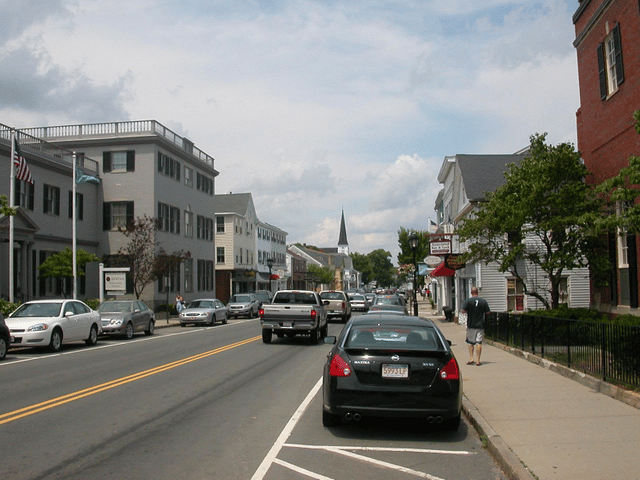
Plymouth, Massachusetts

Plymouth | |
|---|---|
Town | |
| Nickname(s): America's Hometown | |
 Location in Plymouth County in Massachusetts | |
| Coordinates:41°57′30″N 70°40′04″W [121] | |
| Country | United States |
| State | Massachusetts |
| County | Plymouth |
| Region | New England |
| Settled | 1620 |
| Incorporated | 1620[1] |
| Named for | Plymouth, England |
| Government | |
| • Type | Representative town meeting |
| • Town Manager | Melissa Arrighi |
| • Chairman of the Board of Selectmen | Kenneth A. Tavares |
| Area | |
| • Total | 134.0 sq mi (347.0 km2) |
| • Land | 96.5 sq mi (249.8 km2) |
| • Water | 37.5 sq mi (97.2 km2) |
| Elevation | 187 ft (57 m) |
| Population (2010)[4] | |
| • Total | 58,271 |
| • Density | 608.1/sq mi (234.9/km2) |
| Time zone | UTC-5 (Eastern) |
| • Summer (DST) | UTC-4 (Eastern) |
| ZIP Codes | 02345 02360 02361 02362 02381 |
| Area code(s) | 508 / 774 |
| FIPS code | 25-54310 |
| GNIS feature ID | 0618349 |
| Website | www.plymouth-ma.gov [122] |
Plymouth (/ˈplɪməθ/; historically known as Plimouth and Plimoth) is a town in Plymouth County, Massachusetts. The town holds a place of great prominence in American history, folklore, and culture, and is known as "America's Hometown." Plymouth was the site of the colony founded in 1620 by the Mayflower Pilgrims, where New England was first established. It is the oldest municipality in New England and one of the oldest in the United States.[5] The town has served as the location of several prominent events, one of the more notable being the First Thanksgiving feast. Plymouth served as the capital of Plymouth Colony from its founding in 1620 until the colony's merger with the Massachusetts Bay Colony in 1691. It is named after Plymouth, England where the Mayflower set sail for America.
Plymouth is located approximately 40 miles (64 km) south of Boston, Massachusetts in a region known as the South Shore. Throughout the 19th century, the town thrived as a center of rope making, fishing, and shipping, and was home to the Plymouth Cordage Company, formerly the world's largest rope making company. It continues to be an active port, but today its major industry is tourism.[6] The town is served by Plymouth Municipal Airport and contains Pilgrim Hall Museum, the oldest continually operating museum in the United States. It is the largest municipality in Massachusetts by area.[7] The population was 58,271 as of the 2014 U.S. Census. It is one of two county seats of Plymouth County, the other being Brockton.[8]
Plymouth | |
|---|---|
Town | |
| Nickname(s): America's Hometown | |
 Location in Plymouth County in Massachusetts | |
| Coordinates:41°57′30″N 70°40′04″W [121] | |
| Country | United States |
| State | Massachusetts |
| County | Plymouth |
| Region | New England |
| Settled | 1620 |
| Incorporated | 1620[1] |
| Named for | Plymouth, England |
| Government | |
| • Type | Representative town meeting |
| • Town Manager | Melissa Arrighi |
| • Chairman of the Board of Selectmen | Kenneth A. Tavares |
| Area | |
| • Total | 134.0 sq mi (347.0 km2) |
| • Land | 96.5 sq mi (249.8 km2) |
| • Water | 37.5 sq mi (97.2 km2) |
| Elevation | 187 ft (57 m) |
| Population (2010)[4] | |
| • Total | 58,271 |
| • Density | 608.1/sq mi (234.9/km2) |
| Time zone | UTC-5 (Eastern) |
| • Summer (DST) | UTC-4 (Eastern) |
| ZIP Codes | 02345 02360 02361 02362 02381 |
| Area code(s) | 508 / 774 |
| FIPS code | 25-54310 |
| GNIS feature ID | 0618349 |
| Website | www.plymouth-ma.gov [122] |
History
Pre-colonial era
Prior to the arrival of the Pilgrims, the location of Plymouth was a village of the Wampanoag tribe called Patuxet.[9] The region was visited twice by European explorers prior to the establishment of Plymouth Colony. In 1605, Samuel de Champlain sailed to Plymouth Harbor, calling it Port St. Louis. Captain John Smith was a leader of the colony at Jamestown, Virginia, and he explored parts of Cape Cod Bay and is credited with naming the region "New Plimouth."[10]
Colonial era
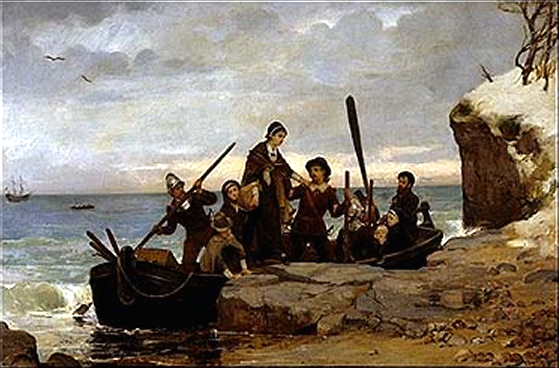
"The Landing of the Pilgrims."(1877) by Henry A. Bacon. The Pilgrims are traditionally said to have landed at Plymouth Rock
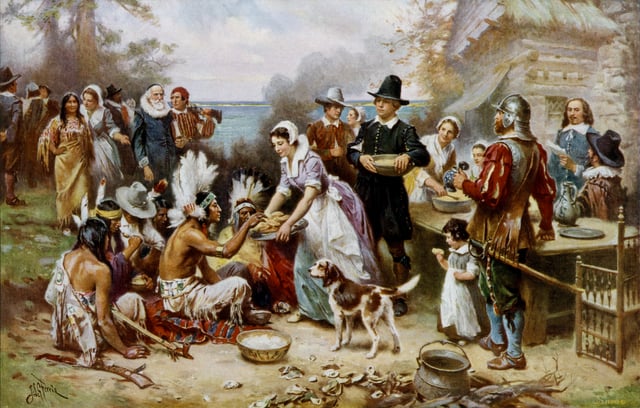
The First Thanksgiving, painted by Jean Leon Gerome Ferris (1863–1930). The First Thanksgiving took place in Plymouth in 1621
Plymouth played a very important role in American colonial history. It was the final landing site of the first voyage of the Mayflower and the location of the original settlement of Plymouth Colony. Plymouth was established in December 1620 by English separatist Puritans who had broken away from the Church of England, believing that the Church had not completed the work of the Protestant Reformation. Today, these settlers are much better known as the "Pilgrims", a term coined by William Bradford.[12]
The Mayflower first anchored in the harbor of Provincetown, Massachusetts on November 11, 1620. The ship was headed for the mouth of the Hudson River near Manhattan, which was part of the Colony of Virginia at the time, but it did not go beyond Cape Cod.[13] The Pilgrim settlers realized that they did not have a patent to settle in the region, so they signed the Mayflower Compact prior to disembarking.[14] They explored various parts of Cape Cod and eventually sought a suitable location for a permanent settlement to the westward in Cape Cod Bay. They discovered the sheltered waters of Plymouth Harbor on December 17, and the protected bay led to a site for the new settlement after three days of surveying.
The settlers officially disembarked on December 21, 1620. It is traditionally said that the Pilgrims first set foot in America at the site of Plymouth Rock, though no historical evidence can prove this claim.[15] They named their settlement "Plimouth" (sometimes spelled "Plimoth") after the major port city in Devon, England from which the Mayflower ultimately sailed.
First Winter

A Plymouth deed signed by Josiah Cotton as Register of Deeds, Courtesy of Shiwei Jiang
Plymouth faced many difficulties during its first winter, the most notable being the risk of starvation and the lack of suitable shelter. From the beginning, the assistance of Native Americans was vital. One colonist's journal reports:[16]
We marched to the place we called Cornhill, where we had found the corn before. At another place we had seen before, we dug and found some more corn, two or three baskets full, and a bag of beans. ... In all we had about ten bushels, which will be enough for seed. It is with God's help that we found this corn, for how else could we have done it, without meeting some Indians who might trouble us.
During their earlier exploration of the Cape, the Pilgrims had come upon a Native American burial site which contained corn, and they had taken the corn for future planting. On another occasion, they found an unoccupied house and had taken corn and beans, for which they made restitution with the occupants about six months later.[17] Even greater assistance came from Samoset and Tisquantum (known as Squanto by the pilgrims), a Native American sent by Wampanoag Tribe Chief Massasoit as an ambassador and technical adviser. Squanto had been kidnapped in 1614 by an English slave raider and sold in Málaga, Spain. He learned English, escaped slavery, and returned home in 1619. He taught the colonists how to farm corn, where and how to catch fish, and other helpful skills for the New World. He also was instrumental in the survival of the settlement for the first two years.
Squanto and another guide sent by Massasoit in 1621 named Hobomok helped the colonists set up trading posts for furs.[18] Chief Massasoit later formed a Peace Treaty with the Pilgrims. Upon growing a plentiful harvest in the fall of 1621, the Pilgrims gathered with Squanto, Samoset, Massasoit, and ninety other Wampanoag men in a celebration of thanksgiving to God for their plentiful harvest. This celebration is known today as the First Thanksgiving, and is still commemorated annually in downtown Plymouth with a parade and a reenactment. Since 1941, Thanksgiving has been observed as a federal holiday in the United States.[19][20]
Plymouth served as the capital of Plymouth Colony (which consisted of modern-day Barnstable, Bristol, and Plymouth Counties) from its founding in 1620 until 1691, when the colony was merged with the Massachusetts Bay Colony and other territories to form the Province of Massachusetts Bay.[21][22][23] Plymouth holds the unique distinction of being the first permanent settlement in New England, and one of the oldest settlements in the United States.[5][24]
19th century

Cordage Commerce Center, North Plymouth
In the 1800s, Plymouth remained a relatively isolated seacoast town whose livelihood depended on fishing and shipping.[25] The town eventually became a regional center of shipbuilding and fishing. Its principal industry was the Plymouth Cordage Company, founded in 1824,[26] which became the world's largest manufacturer of rope and cordage products. At one point, the longest ropewalk in the world was found on the Cordage Company's site on the North Plymouth waterfront, a quarter-mile (0.4 km) in length. It thrived into the 1960s, but was forced out of business in 1964 due to competition from synthetic-fiber ropes.[27] The refurbished factory is home to numerous offices, restaurants, and stores, known as Cordage Commerce Center.[28]
Modern history
Plymouth has experienced rapid growth and development in recent years. It became more accessible to Boston in the early 1970s with improved railroads, highways, and bus routes, and the town's inexpensive land costs and low tax rates were factors in the town's significant population rise, which grew from 18,606 residents in 1970 to 45,608 residents in 1990, a 145% increase in 20 years.[25] Plymouth has surpassed several Massachusetts cities in population, but it is still officially regarded as a town and continues to be governed by a board of selectmen rather than a mayor.
Plymouth spans several exits on the town's primary highway Massachusetts Route 3. Additional access is possible via an extension to U.S. Route 44 in Massachusetts.
Geography
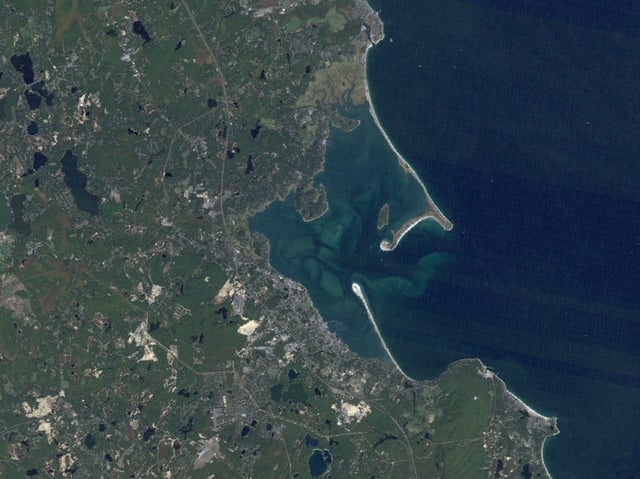
A simulated-color satellite image of the Plymouth Bay region taken on NASA's Landsat 3
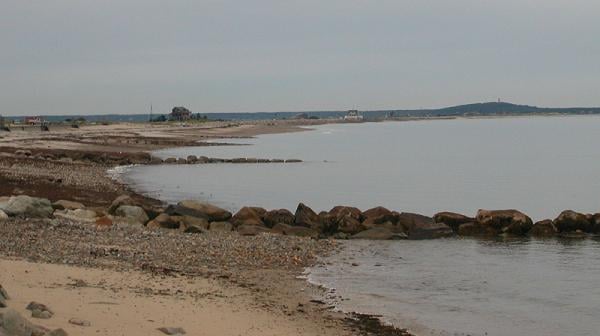
Plymouth Beach, one of Plymouth's many beaches
The latitude of Plymouth is 41.95833 and its longitude is −70.66778.[29][30] According to the United States Census Bureau, the town has a total area of 134.0 sq mi (347 km2), of which 96.5 sq mi (250 km2) is land, and 37.5 sq mi (97 km2) (28%) is water.
With the largest land area of any municipality in Massachusetts, Plymouth consists of several neighborhoods and geographical sections. Larger localities in the town include Plymouth Center, North, West and South Plymouth, Manomet, Cedarville, and Saquish Neck.
Plymouth makes up the entire western shore of Cape Cod Bay. It is bordered on land by Bourne to the southeast, Wareham to the southwest, Carver to the west, and Kingston to the north. It also shares a small border with Duxbury at the land entrance of Saquish Neck.[31] Plymouth's border with Bourne makes up most of the line between Plymouth and Barnstable counties. The town is located roughly 44 miles (71 km) southeast of Boston (it is almost exactly 40 miles (64 km) from Plymouth Rock to the Massachusetts State House) and equidistantly east of Providence, Rhode Island.[32]
Located in the Plymouth Pinelands, the town of Plymouth has many distinct geographical features. The town's Atlantic coast is characterized by low plains, while its western sections are extremely hilly and forested. Plymouth contains several small ponds scattered throughout its western quadrant, the largest being the Great Herring Pond (which is partly in the town of Bourne).[31] A major feature of the town is the Myles Standish State Forest, which is in the southwestern region.[33] Cachalot Scout Reservation, operated by the Cachalot District of the Narragansett Council of the Boy Scouts of America, lies adjacent to the state forest lands. There is also a smaller town forest, as well as several parks, recreation areas and beaches.
Plymouth has nine public beaches, the largest being Plymouth Beach. Plymouth Beach guards Plymouth Harbor and mostly consists of a three-mile (5 km) long, ecologically significant barrier beach. Clark's Island, a small island in Plymouth Bay, is the only island in Plymouth. It is off the coast of Saquish Neck and has nine summer houses but no year-round inhabitants.
Climate
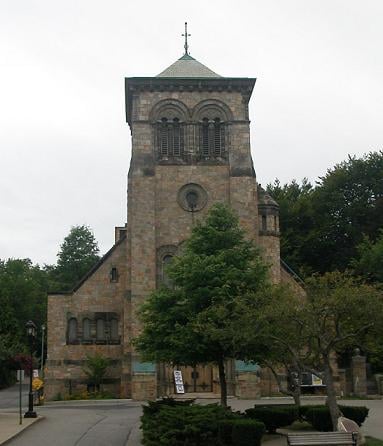
The First Parish Church in Plymouth is located in Plymouth Center
Plymouth has a humid continental climate (Dfb) which is the predominant climate for Massachusetts. Due to its location on the Atlantic Ocean, humidity levels can be very high year-round. Plymouth's coastal location causes it to experience warmer temperatures than many inland locations in New England.[34] Summers are typically hot and humid, while winters are cold, windy and often snowy.
Much like the rest of the Northeastern seaboard, Plymouth receives ample amounts of precipitation year-round. On average, summer months receive slightly less precipitation than winter months. Plymouth averages about 47.4 inches (120 cm) of rainfall a year. Plymouth, like other coastal Massachusetts towns, is very vulnerable to Nor'easter weather systems. The town is sometimes vulnerable to Atlantic hurricanes and tropical storms, which infrequently threaten the Cape Cod region during the early autumn months.
Demographics
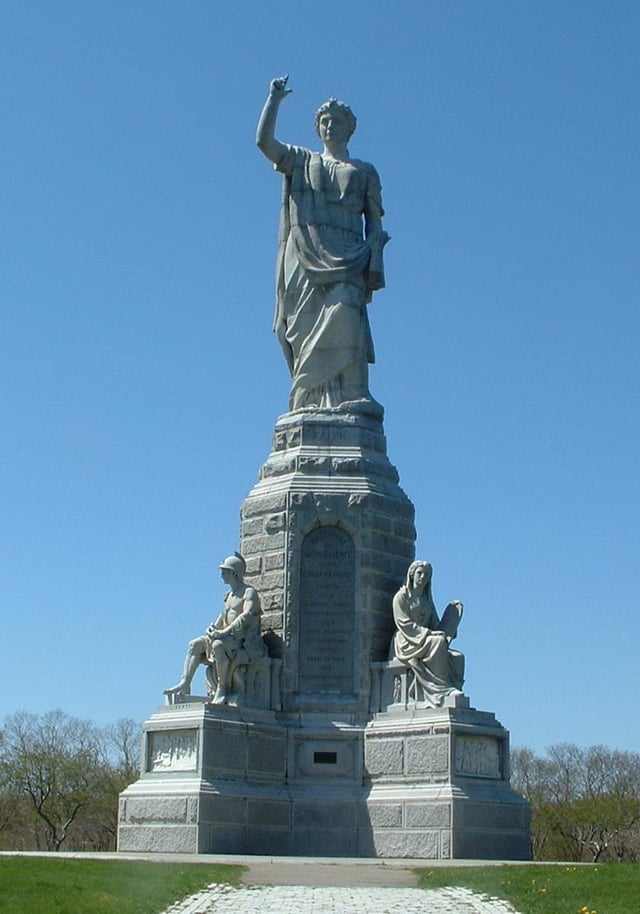
The National Monument to the Forefathers
| Historical population | ||
|---|---|---|
| Year | Pop. | ±% |
| 1790 | 2,995 | — |
| 1800 | 3,524 | +17.7% |
| 1810 | 4,228 | +20.0% |
| 1820 | 4,348 | +2.8% |
| 1830 | 4,758 | +9.4% |
| 1840 | 5,281 | +11.0% |
| 1850 | 6,024 | +14.1% |
| 1860 | 6,272 | +4.1% |
| 1870 | 6,238 | −0.5% |
| 1880 | 7,093 | +13.7% |
| 1890 | 7,314 | +3.1% |
| 1900 | 9,592 | +31.1% |
| 1910 | 12,141 | +26.6% |
| 1920 | 13,045 | +7.4% |
| 1930 | 13,042 | −0.0% |
| 1940 | 13,100 | +0.4% |
| 1950 | 13,608 | +3.9% |
| 1960 | 14,445 | +6.2% |
| 1970 | 18,606 | +28.8% |
| 1980 | 35,913 | +93.0% |
| 1990 | 45,608 | +27.0% |
| 2000 | 51,701 | +13.4% |
| 2010 | 56,468 | +9.2% |
Source: United States Census records and Population Estimates Program data.[37][38][39][40][41][42][43][44][45][46] | ||
As of the census[47] of 2010, there were 56,468 people, 21,269 households, and 14,742 families residing in the town; by population it is the largest town in Massachusetts. It is also the 21st–largest municipality in the state. The population density was 536.0 inhabitants per square mile (207.0/km2).[48] There are 21,250 housing units, at an average density of 85.1/km2 (220/sq mi). The racial makeup of the town was 93.8% White, 2.0% Black or African American, 0.3% Native American, 0.9% Asian, <0.1% Pacific Islander, 0.9% from other races, and 1.48% from two or more races. Hispanic or Latino of any race were 1.8% of the population.[49]
There are 21,269 households out of which 29.5% have children under the age of 18 living with them, 54.6% were married couples living together, 10.8% had a female householder with no husband present, and 30.7% were non-families. 23.7% of all households are made up of individuals, and 10.0% had someone living alone who was 65 years of age or older. The average household size is 2.55 and the average family size is 3.04.
In the town, the population is spread out with 24.3% under the age of 20, 10.7% from 20 to 29, 28.8% from 30 to 49, 22.2% from 50 to 64, and 14.1% who were 65 years of age or older. The median age was 41.4 years.
The median income for a household in the town was $54,677 as of the 2000 census, and the median income for a family was $63,266.[50] Males had a median income of $44,983 versus $31,565 for females. The per capita income for the town was $23,732. About 4.4% of families and 5.4% of the population were below the poverty line, including 7.1% of those under age 18 and 6.9% of those age 65 or over.
Government
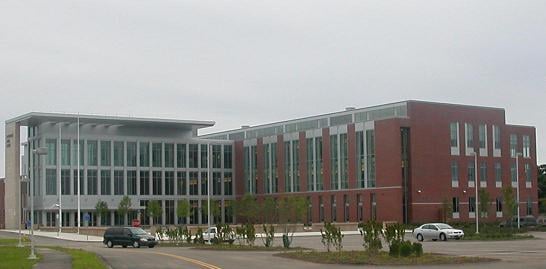
The Plymouth County Courthouse, located in Plymouth
Plymouth is represented in the Massachusetts House of Representatives as a part of the First and Twelfth Plymouth Districts. The town is represented in the Massachusetts Senate as a part of the Plymouth and Barnstable district, which also includes Bourne, Falmouth, Kingston, Pembroke, and Sandwich.[51] On the state level, primary but shared patrolling responsibility of the town's limited access highways falls upon the Seventh (Bourne) Barracks of Troop D of the Massachusetts State Police.[52]
On the national level, Plymouth is a part of Massachusetts's 9th congressional district, and is currently represented by William R. Keating. The state's senior (Class I) member of the United States Senate is Elizabeth Warren. The state's current junior (Class II) Senator is Edward Markey. On the local level, the town uses the representative town meeting form of government, led by a town manager and a board of selectmen.[53] The current town manager of Plymouth is Melissa Arrighi.[54]
Plymouth has a centralized municipal police force, the Plymouth Police Department.[55] The town also has a professional fire department, with seven firehouses spread around the town.[56] There are also six post offices for the town's five ZIP codes, with one in the downtown area, one in North Plymouth, one in Manomet, one in White Horse Beach, one near the Plymouth County Jail, and one near the town forest in "The Village Green" shopping area of The Pinehills.[57][58]
The town has a public library, with a branch location in Manomet.[59] Both libraries are a part of the Old Colony Library Network, which services 28 libraries throughout the South Shore.[60] Additionally, as a seat of Plymouth County, there are several county facilities located in Plymouth. These include a County farm, the Registry of Deeds, two jails (the Massachusetts Correctional Institution – Plymouth and the Plymouth County Correctional Facility) and the County Courthouse..
Economy
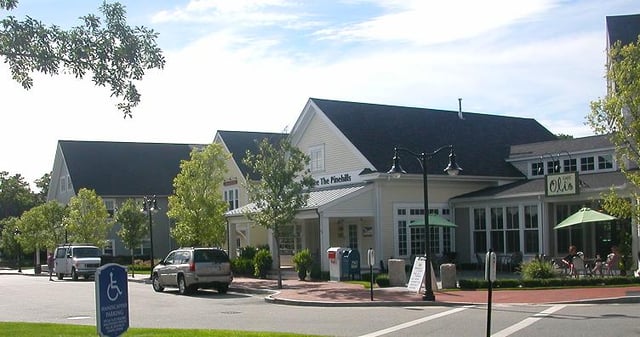
The Pinehills, New England's largest new residential development.
Plymouth is an economic and tourism center of the South Shore. The major industry is tourism, with healthcare, technical and scientific research, real estate, and telecommunications also being primary industries.[6] The largest employer in the town is Beth Israel Deaconess Medical Center.
Plymouth has experienced commercial and industrial success, with the downtown area and North Plymouth each becoming commercial centers and an industrial park opening outside of the town center. A large commercial project titled Colony Place located near the Industrial Park was completed in late 2007. It consists of several large retail stores, various chain restaurants, and contains one of the largest outdoor designer outlet malls in the South Shore.[61] Another large retail development that has recently finished construction off Route 3's exit 5 is The Grove at Plymouth.[62] The only nuclear power plant in Massachusetts, Pilgrim Nuclear Generating Station, is located in Plymouth.
Education
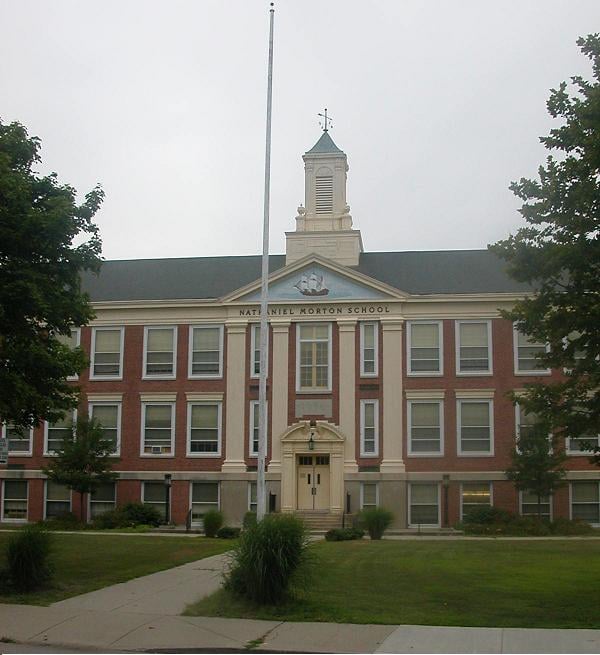
The Nathaniel Morton Elementary School in Plymouth Center
Plymouth operates a large school system, with an enrollment over 8,000 students. The Plymouth School District is one of the largest in the state, operating fourteen schools. This is larger than the Massachusetts average of eight schools.[65] The school district operates 86 school buses under contract with First Student bus company.
The schools in Plymouth include the Mount Pleasant Preschool, eight elementary schools (Cold Spring, Federal Furnace, Hedge, Indian Brook, Manomet, Nathanial Morton, South and West Elementaries) which generally serve students from kindergarten to fifth grade, two middle schools that serve grades 5–8, Plymouth Community Intermediate School (PCIS) and Plymouth South Middle School, and two high schools, Plymouth North and Plymouth South.[66] Both high schools play in the Atlantic Coast League, and the two schools share a rivalry with each other. Students who decide to receive a technical education have the option of attending either Plymouth South Technical School or Plymouth North which now offers Technical studies in either Engineering or Facilities management . There were also 120 home educated children in Plymouth as of 2011.
There is also a charter school in the town, Rising Tide Charter Public School,[67] which serves middle and high school-aged students. Two special education schools, the Baird School and the Radius Pediatric School, are located in the town.
The town has two institutions of higher learning. Quincy College has a campus located in Cordage Park. The Plymouth campus opened in 1991, and the college's main campus is in Quincy.[68] Curry College has a campus at the northern edge of Plymouth Center in the Citizens Bank building. The campus opened in 1994, and the main campus is located in Milton.[69] While the University of Massachusetts Boston does not have a campus in Plymouth, it offers some courses at another location in Cordage Park.[70]
Healthcare
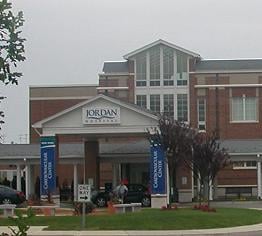
Plymouth's Beth Israel Deaconess – Plymouth Hospital Jordan Hospital
Plymouth is home to Beth Israel Deaconess – Plymouth Hospital (Jordan Hospital), the largest hospital in the southern region of the South Shore. It is the only major healthcare provider in the town. The hospital is a community medical center serving twelve towns in Plymouth and Barnstable counties. It consists of more than 30 departments, with 150 patient beds.[71] The hospital also offers a rehabilitation center in The Pinehills region.
While Beth Israel Deaconess – Plymouth Hospital (Jordan Hospital) is the only hospital in Plymouth. South Shore Hospital operates several offices and physician labs in South Pond. South Shore Hospital, in South Weymouth, is the largest hospital in southeastern Massachusetts.[72]
Transportation
Highways
Plymouth lies along the "Pilgrims Highway" portion of Route 3, which is the major route between Cape Cod and Boston. The town can be accessed from six exits on the highway, which is more than any other municipality along the Pilgrims Highway. Plymouth is also the eastern terminus of U.S. Route 44. The route has changed recently, as a new divided highway section has linked it to Route 3, before heading south and exiting at its old location before terminating at Route 3A, which more closely follows the shoreline and passes through Plymouth Center. Route 80's western terminus is at its intersection with old Route 44. Route 25 goes through a remote section of the town north of Buzzards Bay, but does not have an exit. Finally, the short Plimoth Plantation Highway allows easy access between Routes 3 and 3A, with an exit that allows direct entry to Plimoth Plantation's parking area. The highway is north of Manomet and south of Plymouth Center.
Rail
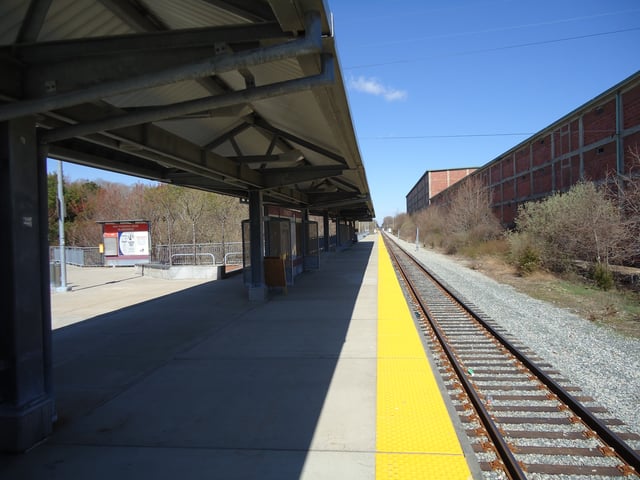
The Plymouth MBTA station, located in Cordage Park
Plymouth is one of two termini of the Kingston/Plymouth Old Colony Line of the Massachusetts Bay Transportation Authority's commuter rail, providing non-peak service to Braintree and as far north as Boston's South Station.[73] The Plymouth MBTA station is near Cordage Park in North Plymouth, along Route 3A.[74] (The other terminus is in Kingston and has more frequent train arrivals and departures. Its station is behind the Independence Mall.) No other railroad lines pass through the town.
Ferry
There is a seasonal ferry to Provincetown and several other excursion lines that offer cruises of Plymouth Bay and Cape Cod Bay. The ferry is operated by Capt. John Boats and offers one round trip daily from June to September. The ferry leaves from the State Wharf in Plymouth Center.[75] In addition to the ferry, Plymouth Harbor offers service for harbor excursions, whale watching tours, and deep sea fishing.
Bus
The Plymouth & Brockton Street Railway Company offers scheduled service to Logan Airport, downtown Boston, Hyannis, and Provincetown. Buses can be boarded at the commuter parking lot at exit 5 off Route 3, behind the McDonald's rest stop.[76] The Greater Attleboro Taunton Regional Transit Authority (GATRA) operates public transportation buses known as the Plymouth Area Link (PAL) throughout much of Plymouth and Kingston.[77]
Air
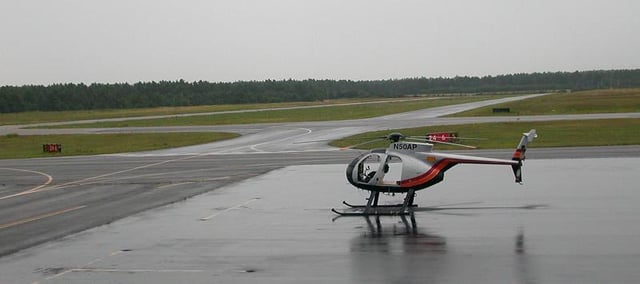
The Plymouth Municipal Airport
The town is home to the Plymouth Municipal Airport, which lies on the border between Plymouth and Carver. Founded in 1931, it offers scheduled service to Nantucket, as well as private service. The airport features a local restaurant and gift shop, but does not have an on-site traffic control tower.[78]
The nearest national and international airport is Logan International Airport in Boston, roughly 43 mi (69 km) away. T.F. Green Airport, a state airport located in Warwick, Rhode Island, is about 63 mi (101 km) away.
Sports
Plymouth is the home of the New England Collegiate Baseball League's Plymouth Pilgrims, who play their home games at Forges Field.
Points of interest
Promoted as America's Hometown, Plymouth is a tourist destination noted for its heritage. The town is home to several notable sites.
Plymouth Rock
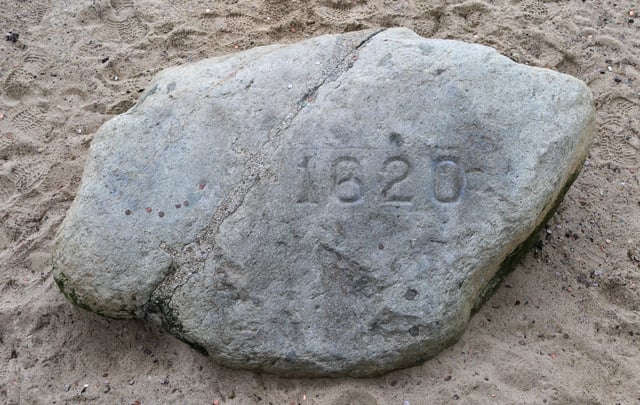
Plymouth Rock, inscribed with 1620, the year of the Pilgrims' landing in the Mayflower
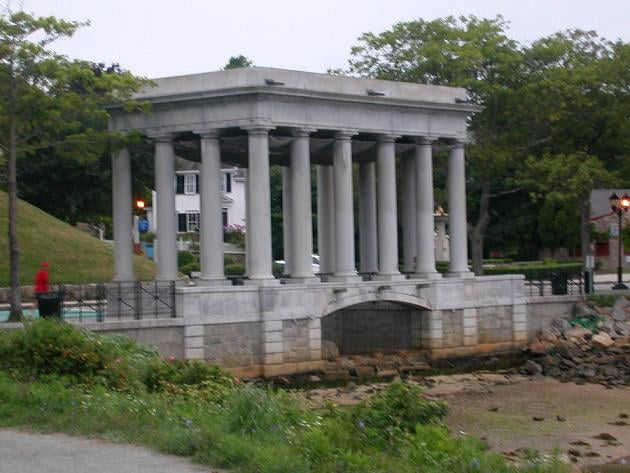
The Plymouth Rock Monument
Plymouth Rock is one of Plymouth's most famous attractions. Traditionally, the rock is said to be the disembarkation site of the Pilgrims. The first identification of Plymouth Rock as the actual landing site was made in 1741 by 94-year-old Thomas Faunce, whose father had arrived in Plymouth in 1623, three years after the arrival of the Mayflower.[81] The rock is located roughly 650 feet (200 m) from where the initial settlement was thought to be built.
Plymouth Rock became very famous after its identification as the supposed landing site of the Pilgrims, and was subsequently moved to a location in Plymouth Center. During the process, the rock split in two. It was later moved to Pilgrim Hall and then to a location under a granite Victorian Canopy, where it was easily accessible and subject to souvenir hunters. The rock was finally moved back to its original location along the town's waterfront in 1921. "Plymouth Rock", a large boulder, now sits under the historic Plymouth Rock Portico. The Neo-Classical Revival structure was designed by the highly influential architectural firm of McKim, Mead and White, designers of the Boston Public Library, Rhode Island State House and the former Pennsylvania Station in New York City. Built in 1921 the existing granite portico replaced an earlier Gothic Revival style monument designed by Hammatt Billings (who also designed the National Monument to the Forefathers). In 1970 the Plymouth Rock Portico was listed in the National Register of Historic Places. The rock and portico are the centerpiece of Pilgrim Memorial State Park. The park is the smallest park in the Massachusetts state forest and park system, but is also the most heavily visited.[82]
Plimoth Plantation
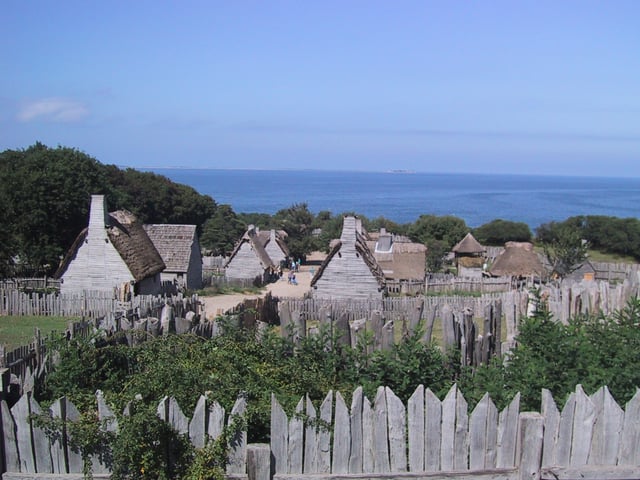
Plimoth Plantation
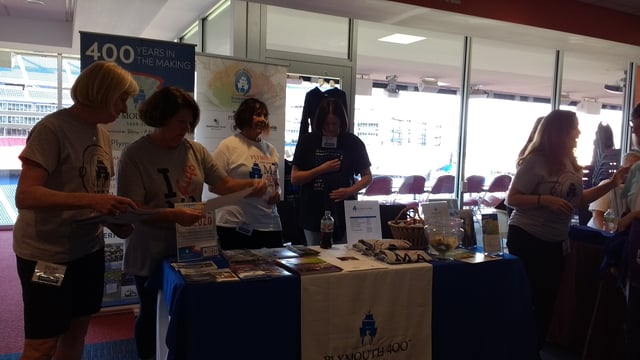
A booth for Plymouth 400, a group planning events for the 400th anniversary of the Mayflower voyage and the founding of Plymouth Colony.
Plimoth Plantation is a living history museum located south of Plymouth Center. It consists of a re-creation of the Plymouth settlement in 1627, as well as a replica of a 17th-century Wampanoag homesite. The museum features role playing tour guides, as well as a large crafts center. The Nye Barn, a replica of a 1627 farming homestead in Plymouth, is also part of the museum. The farm features several animals that would have been found in Plymouth Colony, but are very rare in modern times.[83]
The museum opened in 1947 under the guidance of Henry Hornblower II, a wealthy Boston stockbroker who grew up in Plymouth.[84] The museum originally consisted of the Mayflower II and a "First House" exhibit in Plymouth Center, but was expanded into a large fortified town and a Native American village by 1960.
Mayflower II
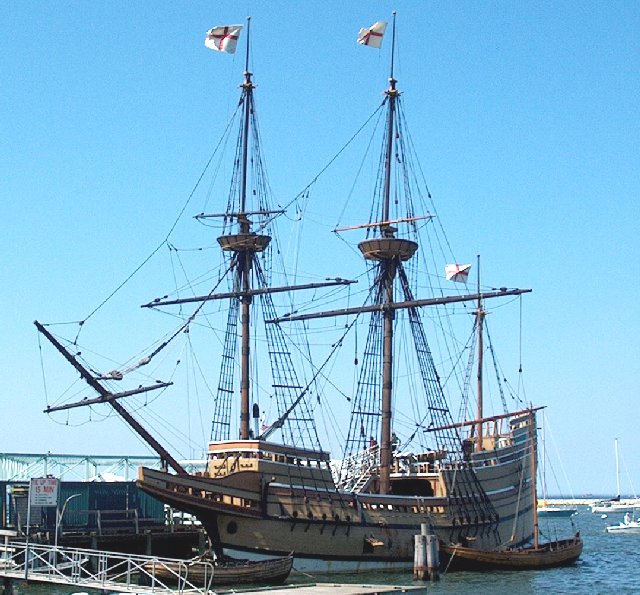
The Mayflower II, located in Plymouth Harbor, is considered to be a faithful replica of the original Mayflower.
The Mayflower II is a full-size replica of the Mayflower, the ship which brought the Pilgrims to Plymouth in 1620. It is located at the State Pier in Plymouth Center. The ship is open as a museum about the Pilgrims' historic voyage from Plymouth, England, and is considered a faithful replica of the original Mayflower.[85] It is officially a part of Plimoth Plantation.
The ship was built in Brixham, England in 1956, and sailed to Plymouth across the Atlantic Ocean in 1957 by famous mariner Alan Villiers.[86] The ship is still seaworthy, and routinely takes voyages around Plymouth Harbor. In the year 2007, the Mayflower II celebrated the 50th anniversary of its arrival in Plymouth.[87]
Other sites
Historic interest
In addition to the Plymouth Rock Memorial, several other monuments were constructed in celebration of Plymouth's tricentennial. These include statues of Massasoit and William Bradford, and a sarcophagus containing the bones of the 51 Pilgrims who died in the winter of 1620, which rests atop Cole's Hill.
Pilgrim Hall Museum, founded in 1824, is the oldest continually operating museum in the United States.[88] It is located in Plymouth Center. Plymouth also features the National Monument to the Forefathers, which was dedicated in 1889.[89] Standing at 81 feet (25 m) tall, it is the tallest free-standing solid granite monument in the United States.[90] Other notable historical sites include the Plimoth Grist Mill, a working replica of an original mill built in 1636 (also officially a part of Plimoth Plantation), as well as the 1640 Richard Sparrow House, the oldest house still standing in Plymouth. At the edge of the town on Route 80 is Parting Ways, a 94-acre (380,000 m2) site that is notable for containing the remains of four former slaves who fought in the American Revolutionary War and their families.[91] Other historic houses include the Mayflower House Museum.
There are 21 locations in Plymouth that appear on the National Register of Historic Places, including Plymouth Rock, Cole's Hill, and Pilgrim Hall.
Parks and recreation
Myles Standish State Forest, the Commonwealth's second largest state forest, is located in Plymouth. It is a camping and hiking destination, and contains 16 freshwater lakes and ponds.[33] It is home to Pinewoods Dance Camp, a traditional dance and music camp listed on the National Register of Historic Places.[92] Ellisville Harbor State Park, located in the extreme southern portion of the town, contains a natural beach inside Cape Cod Bay.[93] Plymouth is also home to 11 public and private golf courses, which include Squirrel Run, Pinehills, Plymouth Country Club, and Southers Marsh, a course that runs through a series of actively maintained cranberry bogs.
Notable people
| Name | Born | Died | Notability and relation to Plymouth |
|---|---|---|---|
| James Warren | 1726 | 1808 | president of the Massachusetts provincial legislature and prominent colonial-era politician. |
| Elkanah Watson | 1758 | 1842 | American Revolution patriot, associate of John Brown (Rhode Island), Travel literature writer |
| Aaron Matson | 1770 | 1855 | a United States Representative from New Hampshire, born in Plymouth[94] |
| Thomas Davee | 1797 | 1841 | United States Representative from Maine, born in Plymouth[95] |
| Oliver Ames, Jr. | 1807 | 1877 | railroad official, former resident of Plymouth[96] |
| John Bartlett | 1820 | 1905 | publisher of Bartlett's Familiar Quotations, born in Plymouth[97] |
| Frederic Augustus Lucas | 1852 | 1929 | Brooklyn Institute of Arts and Sciences museum director, author of many scientific papers, born in Plymouth[98] |
| Violet Mersereau | 1892 | 1975 | silent film actress, died in Plymouth[99] |
| Beatrice Roberts | 1905 | 1970 | film actress |
| Glen Gray | 1906 | 1963 | saxophonist, leader of the Casa Loma Orchestra, born in Plymouth[100] |
| Henry Picard | 1906 | 1997 | Professional golfer, won The Masters Tournament |
| Pee Wee Hunt | 1907 | 1979 | trombonist and co-founder of the Casa Loma Orchestra, died in Plymouth[101] |
| Ken Coleman | 1925 | 2003 | sportscaster, died in Plymouth[102] |
| Dick Gregory | 1932 | 2017 | comedian, activist and nutritionist, resident of Plymouth[103] |
| Peter J. Gomes | 1942 | 2011 | preacher and theologian at Harvard Divinity School, resident of Plymouth[104] |
| Nancy Darsch | 1951 | WNBA Coach, current resident of Plymouth | |
| Warren G. Phillips | 1954 | Inducted into the National Teachers Hall of Fame in 2010, taught in Plymouth | |
| Michael Sweet | 1963 | Lead vocalist and lead and rhythm guitars in Stryper. Resident of Plymouth. | |
| Chris Alberghini | 1965 | television producer-writer, born in Plymouth[105] | |
| Amy Lynn Baxter | 1967 | adult film star and nude model, born in Plymouth[106][107] | |
| Gary DiSarcina | 1967 | former shortstop for the California Angels and manager of the single-A team Lowell Spinners, currently resides in Plymouth. | |
| David Chokachi | 1968 | actor, born in Plymouth.[108] Most known for roles in Baywatch, Witchblade, and Beyond the Break. | |
| Jamie P. Chandler | 1977 | political commentator and author, born in Plymouth[109] | |
| Dave Farrell | 1977 | bassist with Linkin Park, born in Plymouth[110] | |
| Chris Raab | 1980 | Television personality, member of the CKY Crew (Viva La Bam and Jackass). |
Twin and sister cities
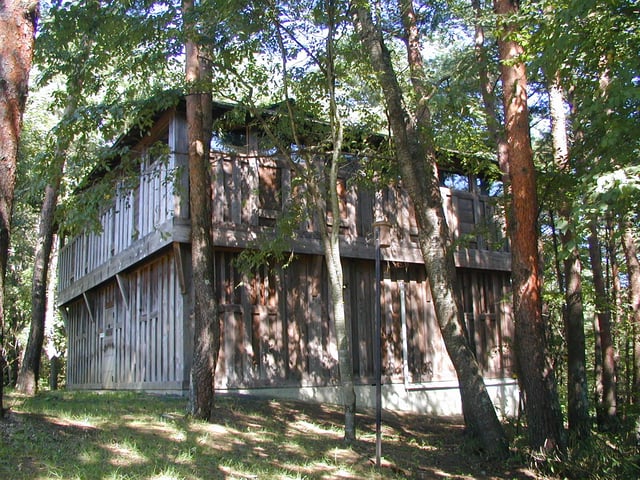
Plymouth House in Shichigahama, modeling after the recreated First Parish Church in Plimoth Plantation
====THE CONTENT BELOW WAS MERGED IN FROM [/lang_en/plymouth-massachusetts-heroin-problem]====
Five people died in Plymouth, Massachusetts in July 2019 of suspected drug overdoses bringing the number of people who have died of suspected drug overdoses in the town in 2019 to seventeen. Police reported twelve overdose deaths locally in 2018.[5]
“It took time for me to become a believer in this epidemic,” Police Chief Botieri said.
Botieri said local police responded to 120 overdoses in 2014, with 15 resulting in deaths.[6]
Plymouth’s per-capita overdose rate is significantly higher than hard-hit Worcester’s, a city three times its size that saw a 59 percent rise in overdoses from 2014 to 2015.The
town has approximately 58,000 people and is 134 square miles, which includes Myles Standish State Forest.
Plainclothes Detectives
As the numbers have grown so has Plymouth's response.A
task force has been formed, an undercover operation using plainclothes detectives made more than two hundred drug arrests in the first half of 2014. The Beth Israel Deaconess Hospital- Plymouth is making substance dependence prevention and treatment a critical priority.
“There is no solution to this unless everybody works together,” stated Fire Chief Bradley said.
“Don’t be afraid.
Don’t hide.
Jump up and down and scream.”[4]
A Major Problem Since 2014
Police responded to 190 overdoses in Plymouth in 2015, with 23 fatalities.In
2014 there were 15 overdose deaths.[8]




